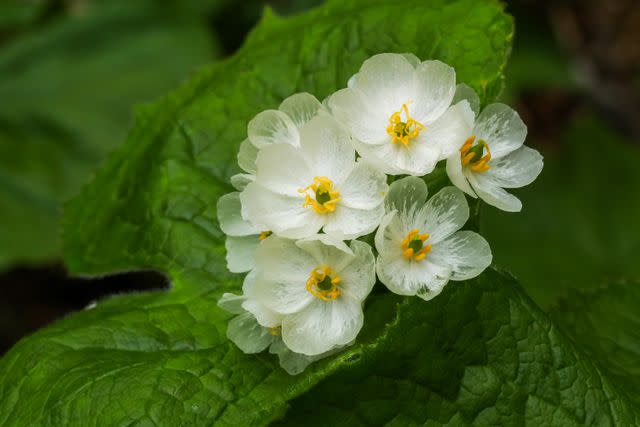Skeleton Flowers Turn Clear When It Rains—Here's How to Grow and Care for This Unusual Perennial
See-through petals show off the striking inner structure of this plant's delicate petals.

Kouzou Yoneyama / GETTY IMAGES
While the name "skeleton flower" may sound like it belongs to a bloom designed for an eerie Halloween centerpiece, this one-of-a-kind flower is more ethereal than ghostly. The delicate white petals are known for a very uncommon trait: They turn clear when they get wet.
Skeleton flowers aren't a commonplace sight at most garden centers, and they have definite preferences when it comes to their growing conditions—but if you live in the right climate, they are a stunning perennial addition to your garden.
Related: 10 White Flowers That Will Add Timeless Beauty to Your Garden
What Are Skeleton Flowers?
Skeleton flowers, or Diphylleia grayi, are slow-growing, deciduous perennials, native to the mountainous regions of Japan. They're members of the Berberidaceae family, which also includes the native North American mayapple as well as Diphylleia cymosa, or umbrella leaf, which grows in the Southern Appalachian region. The plant boasts "conspicuously cleft foliage," says Taylor Johnston of Issima, a specialty nursery in Little Compton, R.I. "White flowers in late spring to early summer give way to blue fruit in late summer."
Clear Petals
The plant is best-known for the transformation it undergoes during rain showers: The petals become clear, showing off the inside skeleton of each. "It's not known what evolutionary advantage this gives the plant, but it seems the translucence is caused by cells in the tissue of the petals," says Johnston.
Where to Grow Skeleton Flowers
To produce their mid-summer blooms, skeleton flowers require conditions similar to the mountain regions of their native habitat, says Kyle Wallick, botanist at the United States Botanic Garden; these are typically found in USDA zones 4 to 9. "This is an outdoor ground-cover type plant for shady locations," he says. "This is a perennial, but slow-growing. Its lifespan should be indefinite; it performs better in montane regions in a cooler climate."
Identify Your Garden Zone Before Planting Skeleton Flowers
Garden vs. Containers
Skeleton flowers, which mature by rhizomes, grow best in the ground—not in containers—say the experts, especially since they require a dormancy period during the winter that's hard to replicate indoors. "This is a tricky plant to grow in a pot, especially because it wouldn't want to be drowning in water when it's dormant in winter," says Johnston. "If you had to, you could keep it in an unheated, shaded spot and keep up on watering in winter, not letting the roots dry out—[but it's] definitely not for indoors."
Skeleton Flower Care
When planted in the correct spot, skeleton flowers don't require pruning or winterizing, and are not plagued by specific pests or diseases. "This is a surprisingly tough and easy enough perennial if you have the right site conditions," says Johnston. "If you follow 'right plant, right place' logic, you won't need to do much of anything, aside from making sure it's not overrun or getting too little water or organic matter every few years."
Sunlight
To mimic the woodlands where the flower grows, plant it in a spot that's primarily shaded, says Wallick; the plant should be protected from harsh, direct sunlight.
Soil
Opt for a "rich, moist loam," but make sure the soil remains well-drained throughout the year, says Wallick.
Water
Skeleton flowers should be kept consistently and evenly moist, says Wallick; water deeply during droughts to maintain hydration levels.
Fertilizer
Skeleton flowers don't need to be fertilized frequently, but the soil in their native habitat is rich with organic matter. If yours isn't, add organic compost or fertilizer.

Kouzou Yoneyama / GETTY IMAGES
How to Add Skeleton Flowers to Your Garden
It's best to transplant mature skeleton flowers directly in the ground—but ready-to-grow plants can be hard to come by. Here's what you need to know about adding this unique variety to your garden, from seed-growing tips to your buying options.
From Seed vs. Mature Plants
Both Wallick and Johnston recommend growing skeleton flowers from established plants instead of from seed. (If you do opt for seed, note that the seeds require vernalization—a cool period that allows them to germinate, says Johnston—and should be sown after seedlings form; this also isn't always successful.) "Skeleton flower is best grown from an established, rooted plant," says Johnston. "They don't love being divided, though it's possible."
Where to Find Skeleton Flowers
Unfortunately, you're not likely to find a skeleton flower ready for transplanting at your corner nursery or local hardware store's plant center. "This is definitely not a big-box store plant," says Johnston. "It's an opportunity to have an adventure and find the treasure-box plant purveyors local to you, or via mail order. There are an increasingly small number of small scale, specialty nurseries and each needs support to continue the work of bringing non-mass-market, special plants to commerce."
Johnston's nursery offers skeleton flowers—with a waitlist—in the early part of the calendar year, but not every year. She recommends beginning your search for the plant in mid-winter to make sure it arrives by spring. "Start looking in February for plants via mail order, and have them shipped after frost has passed to ensure your plant doesn't get zapped," she says.

